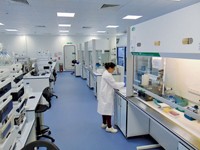Advertisement
Grab your lab coat. Let's get started
Welcome!
Welcome!
Create an account below to get 6 C&EN articles per month, receive newsletters and more - all free.
It seems this is your first time logging in online. Please enter the following information to continue.
As an ACS member you automatically get access to this site. All we need is few more details to create your reading experience.
Not you? Sign in with a different account.
Not you? Sign in with a different account.
ERROR 1
ERROR 1
ERROR 2
ERROR 2
ERROR 2
ERROR 2
ERROR 2
Password and Confirm password must match.
If you have an ACS member number, please enter it here so we can link this account to your membership. (optional)
ERROR 2
ACS values your privacy. By submitting your information, you are gaining access to C&EN and subscribing to our weekly newsletter. We use the information you provide to make your reading experience better, and we will never sell your data to third party members.
Business
Drug Conjugates Lure Investment
Pharmaceuticals: Firms invest in new class of cancer therapies
by Ann M. Thayer
October 21, 2013
| A version of this story appeared in
Volume 91, Issue 42

Only two antibody-drug conjugates are on the market—Roche’s Kadcyla for breast cancer and Seattle Genetics’s Adcetris for lymphoma—but developers are stepping up investment in this new drug class. ADCs promise side-effect-free therapies by linking potent cytotoxins to monoclonal antibodies to deliver a killing agent directly to tumor cells.
Combined sales of Adcetris, approved in 2011, and Kadcyla, approved last year, reached $160 million in the first half of 2013. Even though most other ADCs are still in the early stages of development, the market could grow to $9 billion by 2023, according to the London-based market research firm Roots Analysis.
To support Kadcyla and another eight ADCs in development, Roche will spend about $207 million to build an ADC production facility in Basel, Switzerland. The new plant is part of a larger investment by the company in biologics manufacturing (see page 17).
Meanwhile, AstraZeneca is the latest big pharma firm to buy into the emerging business. This year, Bayer HealthCare, Bristol-Myers Squibb, Novartis, and Pfizer all signed licensing or R&D deals with small ADC technology firms.
AstraZeneca’s biopharmaceutical arm, MedImmune, will spend $200 million up front and up to $240 million in milestone payments to acquire Spirogen, a 13-year-old cytotoxin developer based in London. MedImmune will separately invest $20 million in Switzerland’s ADC Therapeutics and collaborate on developing two ADCs.
With the exception of deep-pocketed firms such as Roche, drug companies developing ADCs are dependent on contract manufacturers, Roots Analysis notes. Only a limited number of contract manufacturers can develop linkers and cytotoxins, and even fewer provide conjugation services, the research firm says.
Sigma-Aldrich’s SAFC contract manufacturing business just announced two expansions aimed at serving ADC developers. By mid-2015, it will add large-scale ADC capacity in St. Louis and expand highly potent compound manufacturing at its Verona, Wis., facility.
The Verona site makes the toxins and linkers that the St. Louis site conjugates to biological molecules. The complementary investments “allow SAFC to offer continuity for customers’ drug development and commercialization programs,” SAFC Operations Director David Bormett says.
Likewise, Carbogen Amcis said last month that it will spend about $4 million on an ADC facility in Bubendorf, Switzerland, and nearly $1 million to upgrade a sterile manufacturing area at its site in Riom, France, for making ADCs. The company just finished upgrading chromatography capabilities in Bubendorf and added a kilogram-scale lab in Bavla, India, for potent compounds.
In July, Piramal Healthcare said it will invest $2.5 million to upgrade commercial-scale ADC production in Grangemouth, Scotland. And earlier this year, Switzerland’s Lonza began doubling its commercial ADC capacity through a $15 million investment in Visp, Switzerland. ADCs represent one of the fastest-growing segments of the biotech industry, the company says.



Join the conversation
Contact the reporter
Submit a Letter to the Editor for publication
Engage with us on Twitter